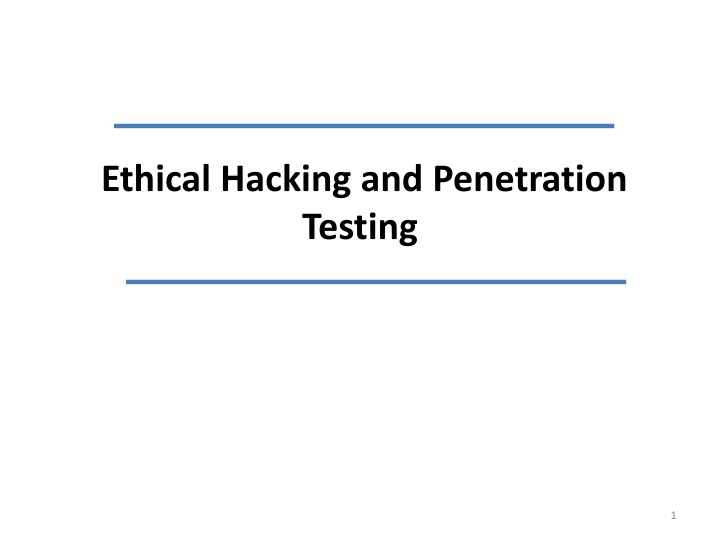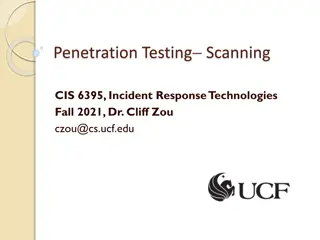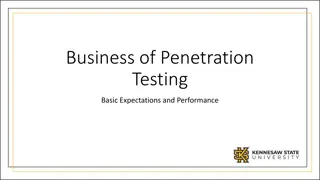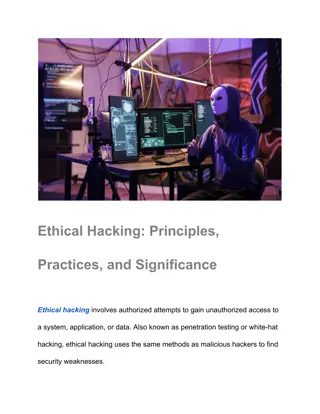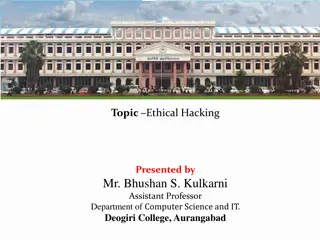Ethical Hacking and Penetration Testing
Let's explore the mindset of penetration testers and ethical hackers, emphasizing the importance of balancing creativity with methodical approaches. Dive into information security (InfoSec) and its critical objectives, such as ensuring confidentiality, integrity, authenticity, availability, and reliability of information.
Download Presentation

Please find below an Image/Link to download the presentation.
The content on the website is provided AS IS for your information and personal use only. It may not be sold, licensed, or shared on other websites without obtaining consent from the author.If you encounter any issues during the download, it is possible that the publisher has removed the file from their server.
You are allowed to download the files provided on this website for personal or commercial use, subject to the condition that they are used lawfully. All files are the property of their respective owners.
The content on the website is provided AS IS for your information and personal use only. It may not be sold, licensed, or shared on other websites without obtaining consent from the author.
E N D
Presentation Transcript
Ethical Hacking and Penetration Testing 1
We break computers, making them do stuff that their designers, implementers, administrator didn t plan on them doing. - Noted penetration tester deployers, and system Day 1: Introduction, Planning, Scoping Day 2: Information Discovery and Re con Day 3: Scanning Day 3: Exploitation Day 4: Maintaining Access Day 5: Reporting and Recommendation Day 6: Pen Test Exercise and Capture the Flag Contest 3
Introduction Let's briefly explore the mindset of penetration testers and ethical hackers That's what our job is: finding flaws that could allow attackers to do evil on target machines, so that vulnerabilities can be fixed before mayhem ensues. However, to successfully achieve that goal, penetration testers and ethical hackers must maintain a mindset that involves two often- contradictory concepts. 4
Introduction Think outside of the box, be pragmatic, do things differently But, at the same time, be thorough, methodical, and careful, take good notes, make your work repeatable Balance between these two is crucial for success 5
Information Security (InfoSec) ISO (27001 and 27002) Information security is all about protecting and preserving information. It s all about protecting and preserving the confidentiality, integrity, authenticity, availability, and reliability of information . 6
Objectives of InfoSec The most critical characteristics of information are confidentiality, integrity, authenticity, availability, reliability. They are the focal point and the primary objectives of information security 7
Key Pen Testing Terms Asset value to an organization, resource that needs protection; it is a target (object) of attackers. Information Assets can be student and customer information, software, hardware. Threat A threat is an agent that may want to or definitely can result in harm to the target organization. Threats include organized crime, spyware, malware, adware companies, and disgruntled internal employees who start attacking their employer. Worms and viruses also characterize a threat as they could possibly cause harm in your organization even without a human directing them to do so by infecting machines and causing damage automatically. Threats are usually referred to as attackers or bad guys . Asset is any tangible or intangible thing that has 8
Key Pen Testing Terms Vulnerability Vulnerability is some flaw in our environment that a malicious attacker could use to cause damage in your organization. Vulnerabilities could exist in numerous areas in our environments, including our system design, business operations, installed software, and network configurations. Risk Risk is where threat and vulnerability overlap. That is, we get a risk when our systems have a vulnerability that a given threat can attack. 9
Key Pen Testing Terms Exploit An exploit is the way or tool by which an attacker uses a vulnerability to cause damage to the target system. The exploit could be a package of code which creates packets that overflow a buffer in software running on the target, which is also known as buffer overflows. Alternatively, the exploit could be a social engineering scheme whereby the bad guy talks a user, preferably an employee into revealing sensitive information, such as a password, over the phone. As security professional, we have to work hard to minimize this risk by minimizing vulnerabilities and blocking threats 10
Key Pen Testing Terms We have to model the activities of real world threats to discover vulnerabilities Then, through controlled exploitation, we attempt to determine the business risk connected with these flaws and vulnerabilities and then recommend appropriate defenses. These recommendations must benefit our target organization. If we do this properly, then the security and protection of our target organization will greatly improve. 11
Types of Attack Active vs. Passive Attack- violates the confidentiality, integrity, availability, and authentication of target environment Active Attack Manipulates target system or information, violates availability or integrity Can also impact authentication & confidentiality Examples: installing backdoor, altering configuration to start a service, manipulate packet flow to sniff 12
Types of Attack Passive Attack Does not modify target instead, intercepts information Tends to focus on violating confidentiality Examples: passively sniffing packets that are being sent to a machine already controlled by the attacker 13
Types of Attack Inside vs. Outside Inside Attack Launched from within a target network Typically launched by an insider employee, contractor, etc.),who may be trusted Sometimes launched by outsider who gains physical access by walking into a building or getting wireless access Outside Attack Launched from outside of physical bounds of a network 14
Security Assessments, Vulnerability Assessments vs. Penetration Testing Many people in the information security field use the phrases Security assessment, or Vulnerability assessment to identify the work done by Penetration testers. But, there is a simple difference between the ideas of a penetration test and a security assessment. 15
Ethical Hacking Definition Hacking (traditional): Manipulating technology to make it do something that it is not designed to do Hacking(sinister):Breaking into computers and network systems without permission Ethical Hacking: Using computer attack techniques to find Security flaws with the permission of the target owner and with the goal of improving the target's security 16
Penetration Testing Penetration testing is the act of attacking an information system to probe security flaws with the permission of the owners of the target system and the purpose of improving the target s security. To prevent a thief think like a thief The actual goal of pen test: compromising target systems and getting access to information 17
Security Assessments Security assessment = vulnerability assessment = penetration testing But there are some differences... Penetration Testing - focus is on getting in or stealing data Security/Vulnerability Assessment- focus is on finding Security vulnerabilities, which may or may not be used to get in or steal data Penetration testing often is intended to go deeper and focus on technical issues Assessments are broader, and often include explicit policy and procedure review Also called "vulnerability assessments" For some people, terms used interchangeably: 18
Security Audits Audit implies testing against a rigorous set of standards Almost always done with detailed checklists While some people have created for penetration testing and security assessments, they tend not to have the depth and rigor of an audit 19
Why Penetration Testing? To find vulnerabilities and exploits in the target environment before the bad guys do To help to make a point to executives about the need for actions or resources Finding and exploiting flaws in an actual penetration test often offers more real-world proof of the need for action than other methods of vulnerability finding Some controversy about the value of penetration testing 20
Addressing Discovered Vulnerabilities Not all discovered vulnerabilities will be addressed However, information security is ultimately about managing risk That's why we need to present our findings in business terms ( We'll discuss reporting later) 21
Types of Penetration Tests There are several types of penetration tests. They involve Network services test: This is one of the most common types of penetration tests, and involves finding target systems on the network, searching for openings in their base operating systems and available network services, and then exploiting them remotely. 22
Types of Penetration Tests Some of these network service penetration tests take place remotely across the Internet, targeting the organization s perimeter networks. Others are launched locally, from the target s own business facilities, to assess the security of their internal network or the DMZ from within, seeing what kinds of vulnerabilities an internal user could learn. 23
Types of Penetration Tests Client-side test This kind of penetration test is intended to find vulnerabilities in and exploit client-side software, such as web browsers, media players, document editing programs, etc. Web application test: These penetration tests look for security vulnerabilities in the web-based applications and programs deployed and installed on the target environment. 24
Types of Penetration Tests Remote dial-up war dials These penetration tests look for modems in a target environment, and normally involve password guessing or brute forcing to login to systems connected to discovered modems. Wireless security test These penetration tests involve discovering a target s physical environment to find unauthorized wireless access points or authorized wireless access points with security weaknesses. 25
Types of Penetration Tests Physical security test These penetration tests look for flaws in the physical security practices of a target organization. Stolen equipment test: This kind of penetration test calls for acquiring a piece of equipment from the target, such as a laptop computer, and then trying to extract sensitive information from it in a laboratory environment. 26
The Phases of an Attack Both malicious and ethical hackers rely on various phases in their attacks: Reconnaissance Scanning Exploitation Malicious attackers often go further, into phases such as: Maintaining access with backdoors and rootkits Covering tracks with covert channels and log editing 27
Limitations of Penetration Testing Penetration testing cannot find all vulnerabilities in a target environment. There are limitations based on the resources and restrictions of a test: Limitations of scope Limitations of time Limitations on access of penetration testers Limitations on methods of penetration testers 28
Limitations of Penetration Testing Additional limitations Limitations of skills of penetration testers Limitations of imaginations of penetration Testers Limitations of known exploits Most of penetration testers do not write their own exploits These limitations can be overcomed by having a highly skilled and experienced set of penetration testers 29
Other Approaches to Find Security Vulnerabilities Configuration review Architecture review Can help determine whether defense-in-depth is applied Interviews with target environment personnel Detailed audits : checklists for systematic analysis of focused security issues 30
The Benefits of other Approaches Config review, arch review, interviews, and audits could be more comprehensive and systematic than penetration testing Each views the enterprise from a different perspective Such activities have less likelihood of crashing a target 31
The Benefits of other Approaches So Why Pen Testing? Where the meets road the rubber" What would actual attacker see? Provide an excellent view of the actual security state of an environment as well as the organization security state Highlight what a real-world bad guy might see if he or she targeted the given organization. Deeper than most audits. Penetration tests engagements also discover subtle flaws that other methods cannot easily discover. unique impact on the time resources of the target organization 32
Vulnerability Research Sources US-CERT:www.us-ert.gov/cas/techalerts Mitre CVE Repository:http://cve.mitre.org Secunia: http://secunia.com Hackerstorm: www.hackerstorm.com Free downloadable Open Source Vulnerability Database with search tool FrSIRT: www.frsirt.com Used to have free exploits, now only the descriptions are free Exploit code is part of commercial subscription service 33
Planning, Scoping and Recon Overall Penetration Testing Process Preparation If applicable sign Nondisclosure Agreement (NDA) Discuss nature of test with target personnel Identify most salient threats and business concerns Agree on rules of engagement Determine scope of test Sign off on permission and notice of danger of testing Assign team Testing Conduct the test Conclusion Perform detailed analysis and reset Reporting and presentation 34
Planning, Scoping and Recon Permission Memo It is vital that you get a signed memo giving you permission to test before you send a single packet This memo is sometimes referred to as a "Get Out of Jail Free Card" GOJFC Limitation of Liability and Insurance By itself, memo is not suitable for pen testing companies to test their client That requires limitations of liability agreement and contractual language Should be drawn up by a lawyer The liability is commonly not to exceed the value of the project 35
Planning, Scoping and Recon Rules of Engagement vs. Project Scope The rules of Engagement and project scope must be defined in advance But, these are separate documents Which comes first? A chicken and the Egg problem Whatever you are more comfortable with comes first But, setting the scope first helps to define the Rules of Engagement 36
Rules of Engagement If you don't have solid Rules of Engagement, you may encounter some nasty issues At a minimum, you ll get low value from your penetration test, wasting time and money Calls from business units angry with you Calls from other companies angry with you Calls from service providers or other third party companies (web hosting...) angry with you Lawsuits? Plan carefully in advance Rules of Engagement define how the test will run The Rules of Engagement should be 1 to 2 pages long, and address each of the following issues 37
Rules of Engagement Contact Information Make sure the testing team and the target organization explicitly exchange emergency contact information Include name, mobile phone number, and in all contact lists Both sides must be available 24X7 during the test duration Keep them close by during entire test Penetration testing team may notice erratic behavior or a crash in a target system, Or, penetration testing might discover evidence of a previous intrusion 38
Rules of Engagement Debriefing Daily Schedule a daily debriefing conference call At the beginning or end of the day (half-hour long) If daily schedule is too onerous, try twice per week during testing interval It ensures everyone is on the same page Discuss the following issues: What the team has done and is in the process of doing Any significant issues discovered so far Whether target personnel have detected the test yet 39
Rules of Engagement Dates and Time of Day Agree upon an explicit start date and a finish date Never let these things go as a total surprise Agree upon acceptable times for testing For particular production environments, some target organizations request evening-only or weekend-only tests 40
Announced vs. Unannounced Will the system administrator or security team of the target be informed of the testing? Or will their response to a surprise test be measured? Either way is a valid test However, be very careful with unannounced test! The system and network admins may discover the scans and then shun traffic Every test done after that point is invalid, and waste of your time and money! 41
Announced vs. Unannounced Speaking of Shunning Check to see whether any automated system (IDS and/or IPS) might reconfigure the network access , blocking the attack That could result in a denial of service condition Or a wasted penetration test More on Shunning If the target sys admin or technology responds to the test by shunning , will this conclude the testing Is this considered a successful response by the targeted organization? If this does NOT conclude the testing, what actions will be taken then to acknowledge the response and resume additional testing, and will additional approval be required to continue such testing? 42
Black Box vs. Crystal Box Testing Will the testers be given network diagrams and system descriptions? Reasons for black box testing: "More like the real world attackers" - but is that really true? Don't let my deficient architecture docs bias your test Reasons for crystal box testing: More cost effective Attackers may have this stuff (dumpster diving, insider attacks) Less chance of an error causing damage to systems Although most penetration testers do both types of testing, most prefer the crystal box variety Hybrid approaches are possible, but more costly 43
Black Box vs. Crystal Box Testing Viewing Data on Compromised Systems If the testing team successfully compromised a target host, what limits should there be on viewing data on the host? The recommendation is prohibiting user information from viewing There could be personal or customer information , viewing of such data could violate privacy regulation 44
Finalizing Pen Test Planning You really should agree on all of these issues before you start Document your agreement and have everyone signoff Target Organization Head of the team Possibly the individual testers themselves Good set of Rules of Engagement makes your testing more thorough and valuable 45
Scoping what are the concerns? Ask the target organization: what are your biggest security concerns? Disclosure of sensitive information Interruption of production processing Embarrassment due to defacement of website Compromising of a machine to use as a jump- off point for deeper penetration 46
Scoping Avoiding Scope Creep Discuss threats, risks, and already-known vulnerabilities This is a kind of brainstorming session Discuss how to best test these areas of concern Be careful to keep focused We don't want scope creep If there is no focus, suggest the test include the low-hanging fruit to start 47
Scoping Setting the Scope-what to test? Establish a clear and explicit scope for the test What is to be tested? Specific domain names Network address ranges Individual hosts Particular applications What should be explicitly avoided? Document these in advance and check when additional items are discovered before attacking them 48
Scoping Scope of Test - Third Parties Make sure to get explicit (written) permission to test the equipment of any third parties ISPs (routers, switches, mail, servers, DNS servers, etc...) Web hosting companies Possibly a single web server housing dozens of companies' web sites Others 49
Scoping How should the target systems be tested? Ping sweep of network ranges Port scan of target hosts Vulnerability scan of targets Penetration into targets Give me shell or give me death Application-level manipulation Client-side Java/ActiveX reverse engineering Physical penetration attempts Social engineering of people (more on this later...) 50
